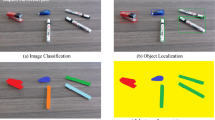Abstract
Semantically accurate segmentation of an object of interest (OOI) is a critical step in computer vision tasks. In order to bridge the gap between low-level visual features and high-level semantics, a more complete model of the OOI is needed. To this end, we revise the concept of directional spatial templates and introduce regional directional spatial templates as a means of including spatial relationships among OOI regions into the model. We present an object segmentation algorithm that learns a model which includes both visual and spatial information. Given a training set of images containing the OOI, each image is oversegmented into visually homogeneous regions. Next, Multiple Instance Learning identifies regions that are likely to be part of the OOI. For each pair of such regions and for each relationship, a regional template is formed. The computational cost of template generation is reduced by sampling the reference region with a pixel set that is descriptive of its shape. Experiments indicate that regional templates are an effective way of including spatial information into the model which in turn results in a very significant improvement in segmentation performance.
Access this chapter
Tax calculation will be finalised at checkout
Purchases are for personal use only
Preview
Unable to display preview. Download preview PDF.
Similar content being viewed by others
References
Carson, C., Belongie, S., Greenspan, H., Malik, J.: Blobworld: color and texture-based image segmentation using EM and its applications to image querying and classification. IEEE Transactions on Pattern Analysis and Machine Intelligence 24(8), 1026–1038 (2002)
Vicente, S., Kolmogorov, V., Rother, C.: Graph cut based image segmentation with connectivity priors. In: Proceedings of IEEE Conference on Computer Vision and Pattern Recognition, pp. 1–8 (2008)
Peng, J., Bhanu, B.: Closed-loop object recognition using reinforcement learning. IEEE Transactions on Pattern Analysis and Machine Intelligence 20(2), 139–154 (1998)
Crandall, D.J., Huttenlocher, D.P.: Weakly Supervised Learning of Part-Based Spatial Models for Visual Object Recognition. In: Leonardis, A., Bischof, H., Pinz, A. (eds.) ECCV 2006. LNCS, vol. 3951, pp. 16–29. Springer, Heidelberg (2006)
Viola, P., Platt, J.C., Zhang, C.: Multiple instance boosting for object detection. Advances in Neural Information Processing Systems 18, 1417–1424 (2006)
Gondra, I., Xu, T.: A multiple instance learning based framework for semantic image segmentation. Multimedia Tools and Applications 48(2), 339–365 (2010)
Dietterich, T., Lathrop, R., Lozano-Perez, T.: Solving the multiple-instance problem with axis-parallel rectangles. Artificial Intelligence 89(1-2), 31–71 (1997)
Todorovic, S., Ahuja, N.: Extracting subimages of an unknown category from a set of images. In: Proceedings of IEEE Conference on Computer Vision and Pattern Recognition, pp. 927–934 (2006)
Alam, F.I., Gondra, I.: A bayesian network-based tunable image segmentation algorithm for object recognition. In: Proceedings of IEEE International Symposium on Signal Processing and Information Technology, pp. 11–16 (2011)
Matsakis, P., Ni, J., Wang, X.: Object localization based on directional information: Case of 2d raster data. In: Proceedings of IAPR International Conference on Pattern Recognition, pp. 142–146 (2006)
Maron, O., Lozano-Perez, T.: A framework for multiple instance learning. In: Proceedings of the Conference on Advances in Neural Information Processing Systems, vol. 10, pp. 570–576 (1998)
Xu, T., Gondra, I., Chiu, D.: Adaptive kernel diverse density estimate for multiple instance learning. In: Proceedings of 2011 International Conference on Machine Learning and Data Mining, pp. 185–198 (2011)
Bloch, I.: Fuzzy relative position between objects in image processing: A morphological approach. IEEE Transactions on Pattern Analysis and Machine Intelligence 106, 657–664 (1999)
Logan, G.D., Sadler, D.D.: A computational analysis of the apprehension of spatial relations. In: Language and Space. MIT Press, Cambridge (1996)
Gapp, K.P.: Basic meaning of spatial relations: Computation and evaluation in 3d space. In: Proceedings of National Conference on Artificial Intelligence, pp. 1393–1398 (1994)
Olivier, P., Tsuji, J.I.: Quantitative perceptual representation of prepositional semantics. Artificial Intelligence Review 8, 147–158 (1994)
Goshtasby, A.: Description and discrimination of planar shapes using shape matrices. IEEE Transactions on Pattern Analysis and Machine Intelligence 7(6), 738–743 (1985)
Arthur, D., Vassilvitskii, S.: K-means++: The advantages of careful seeding. Technical Report 2006-13, Stanford InfoLab (June 2006)
Author information
Authors and Affiliations
Editor information
Editors and Affiliations
Rights and permissions
Copyright information
© 2012 Springer-Verlag Berlin Heidelberg
About this paper
Cite this paper
Gondra, I., Alam, F.I. (2012). Learning-Based Object Segmentation Using Regional Spatial Templates and Visual Features. In: Bolc, L., Tadeusiewicz, R., Chmielewski, L.J., Wojciechowski, K. (eds) Computer Vision and Graphics. ICCVG 2012. Lecture Notes in Computer Science, vol 7594. Springer, Berlin, Heidelberg. https://doi.org/10.1007/978-3-642-33564-8_48
Download citation
DOI: https://doi.org/10.1007/978-3-642-33564-8_48
Publisher Name: Springer, Berlin, Heidelberg
Print ISBN: 978-3-642-33563-1
Online ISBN: 978-3-642-33564-8
eBook Packages: Computer ScienceComputer Science (R0)




